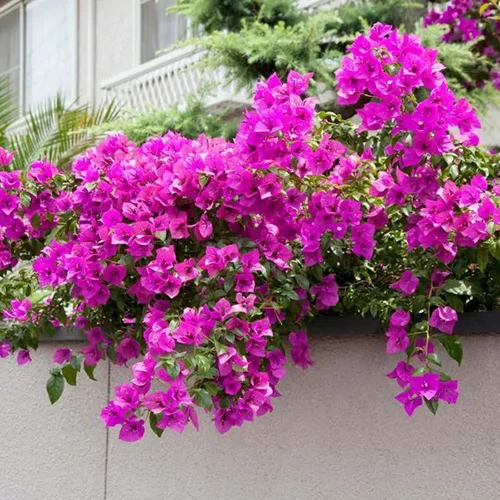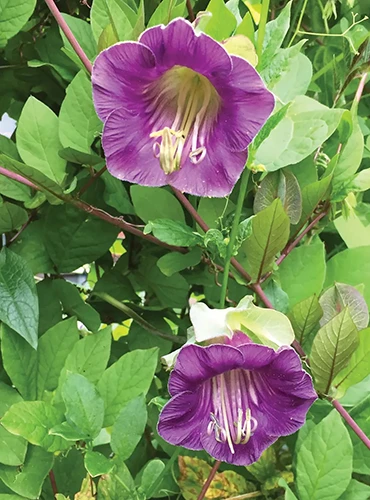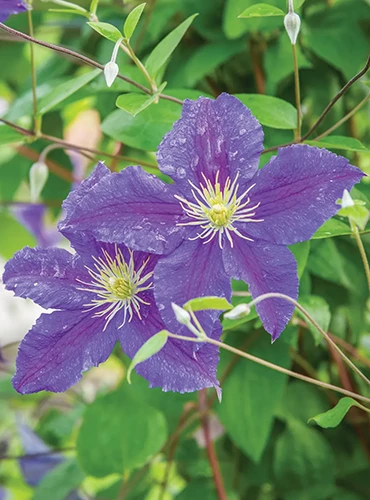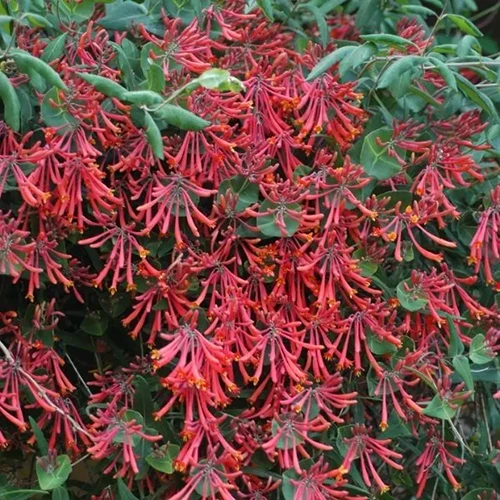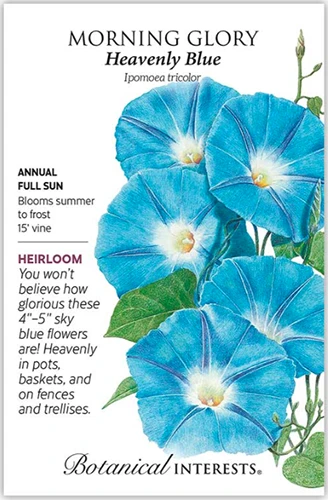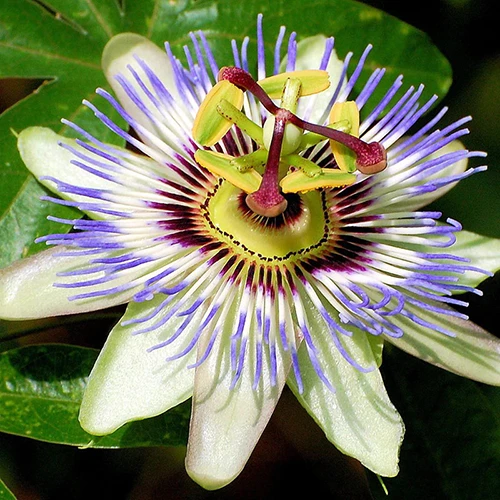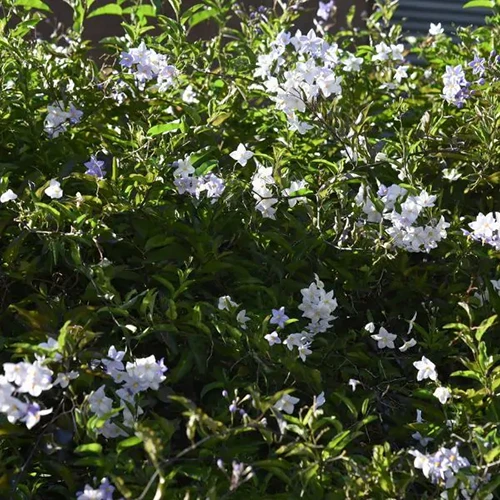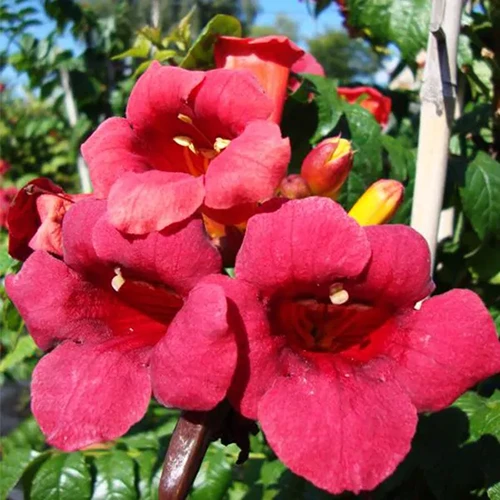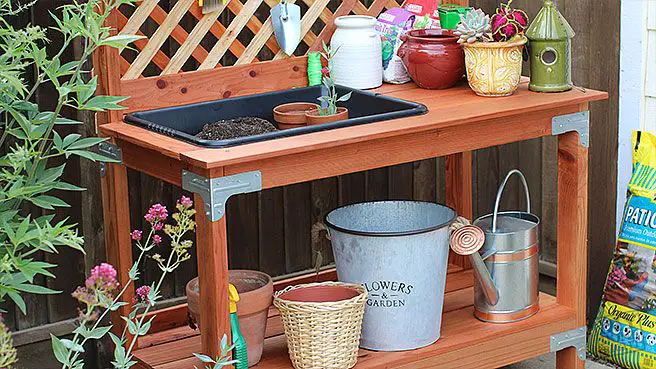19 of the Finest Vines for Vibrant Summer season Colour
With their distinctive, climbing behavior, vines are the right vegetation for including vertical curiosity with vivid summer season colours to the backyard.
Most are quick rising, and their clinging or twining tendrils and good-looking, lush foliage shortly covers and softens upright buildings comparable to arbors, fences, porches, and patio privateness screens.
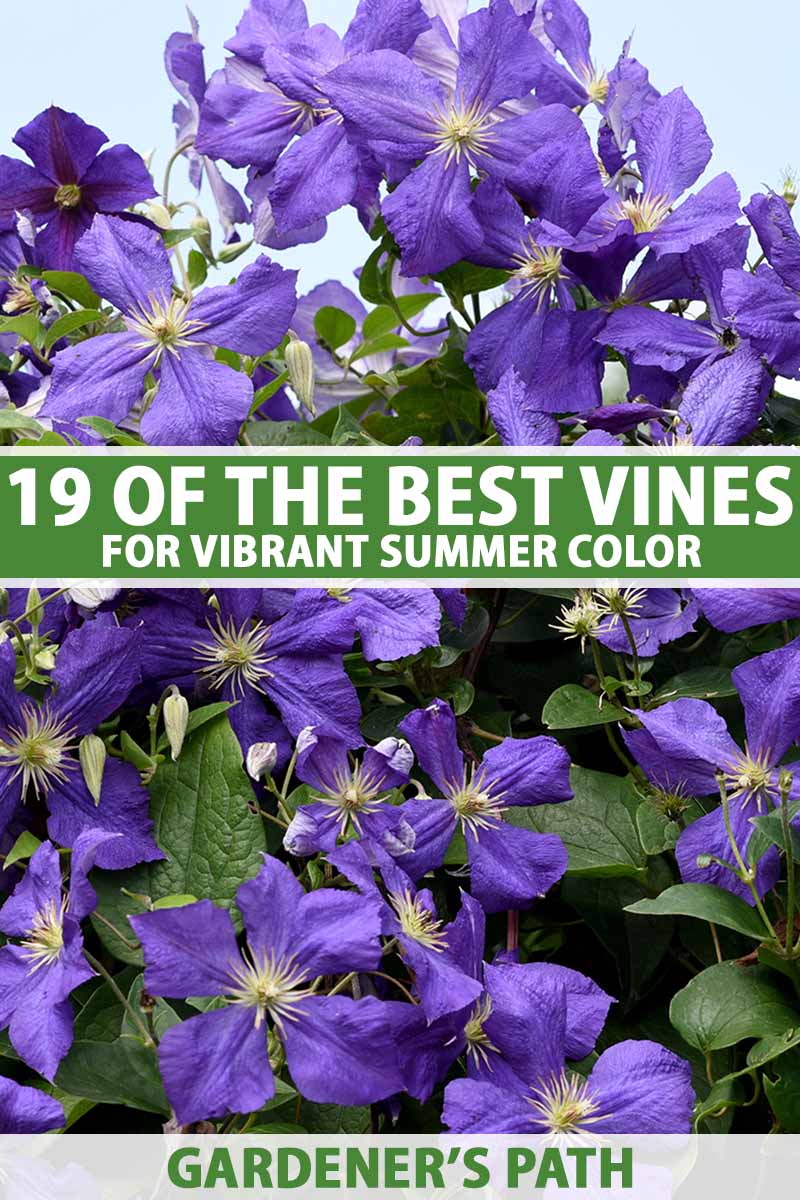
We hyperlink to distributors that will help you discover related merchandise. Should you purchase from certainly one of our hyperlinks, we could earn a fee.
Additionally they add a fantastic number of flowers, with vivid, daring colour, fascinating shapes, and infrequently a candy perfume as properly – good for attracting necessary and fascinating pollinators like bats, bees, butterflies, and hummingbirds.
And plenty of are herbivore resistant as properly, unappealing to the likes of deer, rabbits, and squirrels.
Some have good chilly hardiness and may stand up to freezing temperatures, whereas many are frost tender.
However they’re as simply cultivated in containers as within the floor.
Potted lianas additionally climb robustly and could be pruned again to a manageable measurement to overwinter indoors, to allow them to be loved in any local weather.
Lush, fast-growing, and with perfumed, colourful flowers… Is your patio, pergola, or porch in want of some thrilling vining curiosity this 12 months? Then let’s climb into our roundup of 19 vines for vibrant summer season colour!
Right here’s a fast preview of all of our picks that made the listing:
19 Finest Summer season-Flowering Vines
1. Bittersweet
A favourite for crafts and dried flower preparations, American bittersweet (Celastrus scandens) is a high-climbing perennial that offers a protracted season of curiosity.
The flowers are principally insignificant, however the berries are vivid and exquisite.

In June, small greenish-white flowers arrive that turn into drooping clusters of gold to inexperienced, pea-sized berries in summer season.
By fall, the colourful berries have ripened to vivid orange and the fruit capsules cut up open to disclose scarlet arils. These function a winter meals for pheasants, ruffed grouse, and songbirds.
These climbers attain a top of as much as 30 ft in full solar and the foliage turns vivid yellow in fall. However you want each female and male vegetation to provide fruit.
Native to jap areas of Central and North America, bittersweet is hardy in USDA Zones 3 to eight.
Additionally, you’ll wish to make sure you’re selecting American bittersweet, C. scandens.
Its shut relative Oriental bittersweet, C.orbiculatus, seems to be related, however the Asian species is an aggressive, invasive weed in some areas.
2. Bleeding Coronary heart Vine
A bushy, tropical species from west Africa, bleeding coronary heart vine (Clerodendrum thomsoniae) has shiny evergreen leaves and produces improbable terminal clusters of flowers with bell-shaped, white calyxes adorned with a small purple flower poking from the underside.
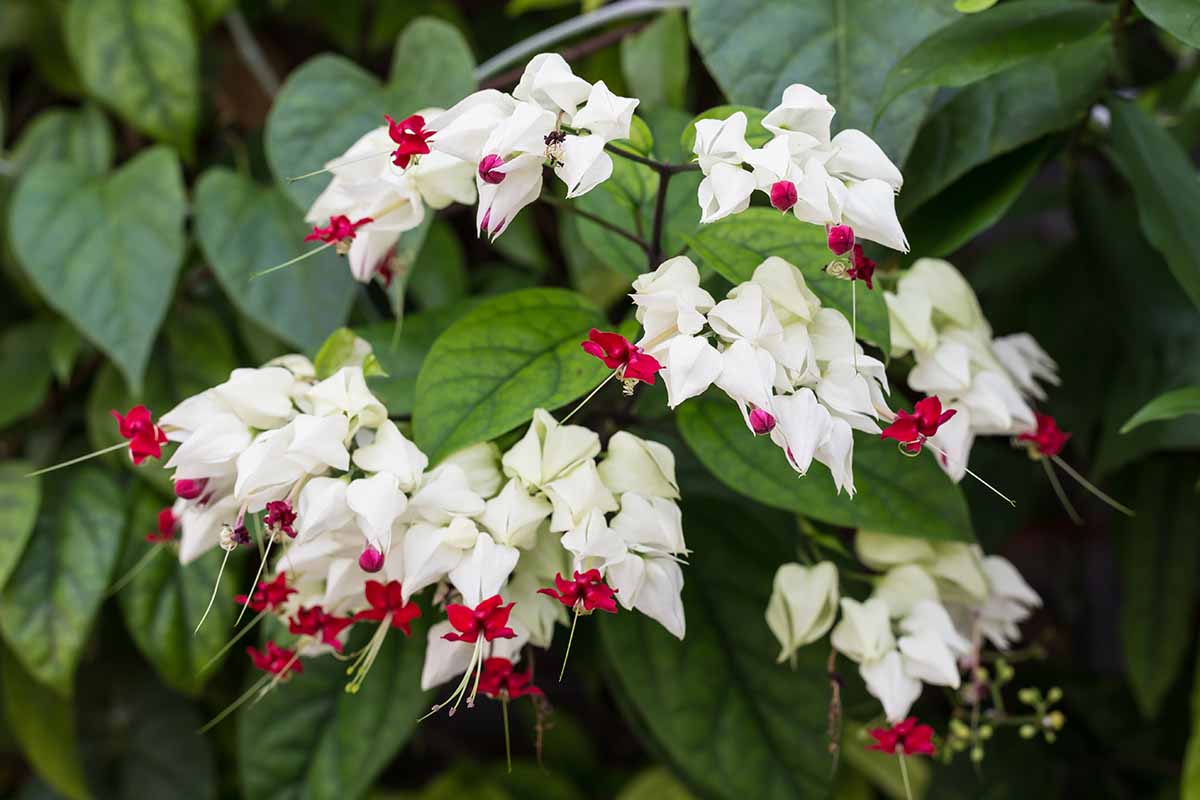
The flippantly aromatic flowers bloom all through summer season, attracting bees and butterflies, and the calyxes change from white to pink to mauve because the flowers age.
This is a perfect alternative for partial or dappled shade in constantly moist and well-draining soil.
Twining and non-invasive, the stems develop as much as 15 ft however are hardy solely in Zones 9 and above.
In colder areas, develop bleeding coronary heart vine as an annual or in containers that may be moved indoors for winter safety.
3. Bougainvillea
A flamboyant decorative from jap South America, twining bougainvillea (Bougainvillea spp.) makes a daring assertion grappling over banks or architectural options in Mediterranean gardens, patios, and poolside oases.
They thrive in baking solar, full-on warmth, and lean soil, and may scramble near 40 ft.
The foliage virtually disappears because the colourful bracts flower all summer season lengthy, masking the lengthy, thorny canes in shades of cherry, fuchsia, pink, mauve, orange, salmon, white, or yellow.
Bees, butterflies, and moths are interested in the small flowers throughout the bracts. Hardy in Zones 9 and above, plant frost-tender bougainvillea in containers in cooler areas and transfer it indoors for winter.
‘Elizabeth Angus,’ with attractive, neon mauve flowers, is obtainable in containers at Nature Hills Nursery.
Our information on easy methods to develop and look after bougainvillea has all of the cultivation particulars you’ll want.
4. Cathedral Bells
A quick-growing, tender perennial that makes a beautiful, flowering display, cathedral bells, or cup and saucer vine (Cobaea scandens), options sweetly aromatic, bell-shaped flowers with an ornate sepal ruff from midsummer to fall.
Climbing and clinging with tendrils and hooks, these Mexican natives unfold as much as 20 ft and produce purple or white flowers in a full solar location with moist, well-draining soil.
The big, tubular flowers are pollinated by nectar bats, bees, and butterflies. Hardy in Zones 9 to 11, vegetation in colder areas could be grown as annuals or in a container moved inside for winter.
Cathedral bells seeds are accessible from Burpee.
5. Clematis
Summer season-flowering clematis (Clematis spp.) are these vegetation that flower in Group C (or 3).
They usually flower in June and July with a repeat bloom in September, or they flower repeatedly from June till frost, relying on the cultivar.
Flower colours, form, and measurement can differ enormously on this group starting from the extremely fashionable, royal purple ‘Jackmanii’ to the lots of sunshine yellow blooms of ‘Golden Tiara.’
Most varieties develop within the vary of six to fifteen ft, though ‘Candy Autumn’ can attain so far as 30 ft.
Bees and butterflies go to the flowers, and the comfortable down from spent seedheads gives cozy nesting supplies for winter-mating birds just like the Anna’s hummingbird.
To get a greater really feel for Group C choices, take a look at our information to 19 of one of the best summer-flowering clematis varieties.
‘Jackmanii’ is a traditional and much-loved summer season clematis. Container vegetation are accessible at Burpee.
And have a learn of our information to rising clematis for full cultivation particulars.
6. False Hydrangea
With delicate flowers just like lacecap hydrangeas, false hydrangea vine (Schizophragma hydrangeoides) is a deciduous, woody-stemmed climber with lovely, giant clusters of white or pink flowers (really bracts) that bloom in June and July.
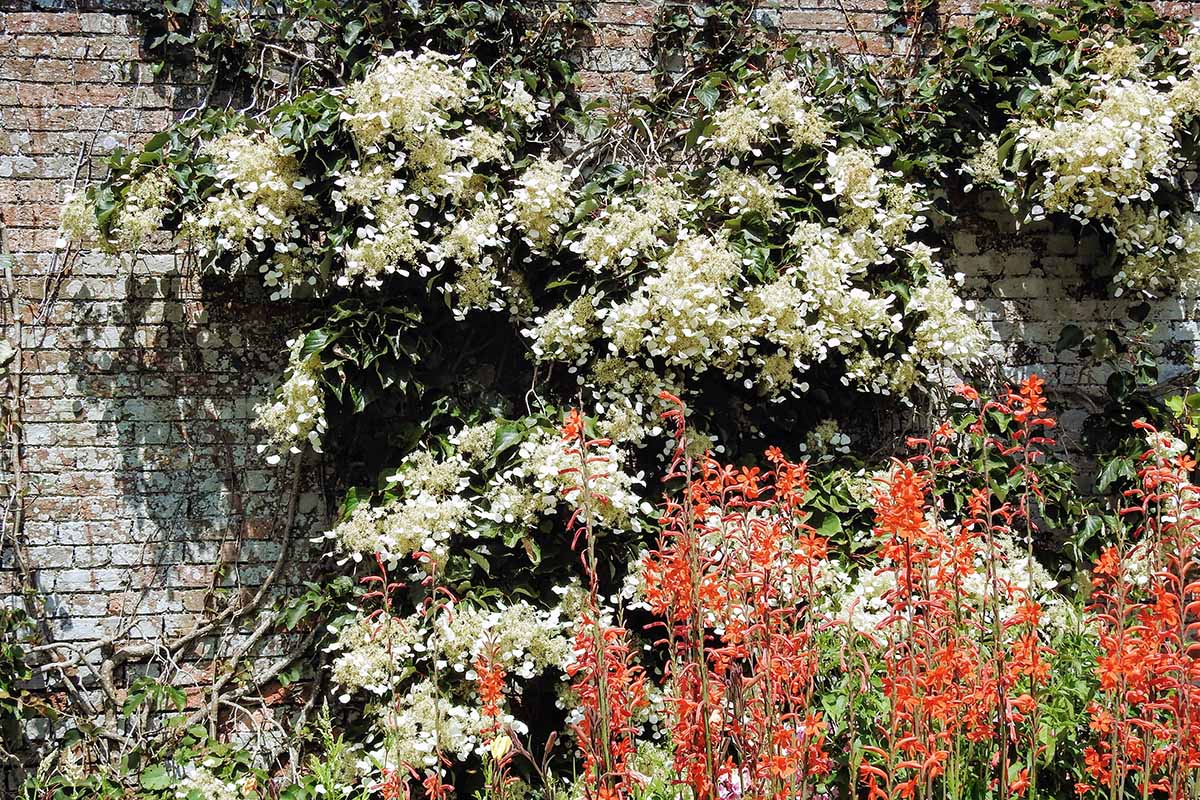
Native to Japan and Korea, the lengthy lianas climb to a top of 40 ft utilizing stem rootlets to connect to surfaces.
False hydrangea vine makes a wonderful alternative for a fan of full shade places in moist, well-draining soil.
The ethereal flowers entice bees and butterflies and the good-looking, heart-shaped leaves give a superb present of yellow foliage in autumn. Hardy in Zones 5 to 9.
‘Flirty Woman’ container vegetation are accessible at House Depot.
7. Honeysuckle
A favourite supply of nectar for hummingbirds, twining honeysuckle (Lonicera spp.) stems are coated in sweetly scented, tubular or trumpet-shaped flowers.
Flowering from mid-spring to midsummer in shades of coral, cream, orange, peach, pink, salmon, scarlet, and yellow, the self-clinging stems attain a top of 10 to 30 ft and are hardy in Zones 5 to 9.
A aromatic and fairly alternative for climbing and scrambling, a few of the launched species have escaped cultivation and turn into invasive in some areas.
Nonetheless, some native North American species supply good-looking, non-invasive choices for residence progress.
Like ‘Main Wheeler’ (L. sempervivens), which is famous for its fabulous clusters of firecracker-red flowers and has the longest bloom time of all species, flowering from late spring to late summer season.
Container vegetation of ‘Main Wheeler’ could be discovered at Nature Hills Nursery.
Our information on easy methods to develop climbing honeysuckle has all of the cultivation particulars you want for wholesome vegetation.
8. Jasmine
Vigorous deciduous or evergreen vines that twine to climb, jasmine (Jasminum spp.) produces spectacular clouds of aromatic white or pink flowers on arbors, arches, fences, patio screens, and trellises.

A few fashionable summer-blooming varieties that develop as much as 20 ft embody the white or pink-flowered widespread or poet’s jasmine, J. officinale, which is hardy in Zones 8 to 11 or the pink-flowered Stephan jasmine (J. x stephanense), hardy in Zones 7 to 10.
In colder areas, develop vegetation in containers and convey them indoors for winter.
This information has the lowdown on easy methods to develop jasmine.
9. Kiwi
For top-reaching splashes of cream and pink, the variegated kiwi (Actinidia kolomikta) is a vigorous, twining climber grown primarily for its flamboyant foliage.
Native to Asia, clusters of aromatic, white, apple-like blossoms flower in early summer season however are principally hidden by the dense cover of heart-shaped leaves of deep inexperienced, cream, and rosy pink.
The flowers entice pollinators like birds and butterflies however each female and male vegetation are wanted to provide fruit.
‘Arctic Magnificence’ Variegated Kiwi
Variegated kiwi grows as much as 20 ft in a sunny to flippantly shaded location.
It wants fertile, well-draining soil and durable helps to climb on, comparable to an arbor, fence, or trellis. Hardy in Zones 4 to eight.
Container vegetation of the variegated ‘Arctic Magnificence’ are accessible at Nature Hills Nursery. It is a male cultivar, identified for having higher leaf variegation.
10. Mandevilla
Splendid for including steamy splashes of perfume and colour to arbors, patio screens, and trellises, mandevilla (Mandevilla spp.) is a fast-growing, twining plant loaded with trumpet-shaped flowers in vivid shades of orange, salmon, pink, purple, white, and yellow.
Awash in showy flowers all summer season, the beautiful blooms are visited by bees, butterflies, and hummingbirds.
The stems develop as much as 20 ft and love warmth and humidity, hailing from tropical and subtropical areas of the Americas.
Hardy in Zones 9 to 11, these frost-tender vegetation could be grown as annuals or planted up in containers and moved indoors for winter.
Container vegetation of pink, purple, or white mandevilla are accessible at Planting Tree.
11. Morning Glory
Native to the tropics of the Americas, morning glory (Ipomoea tricolor) is a quick rising, twining plant with giant flowers in vibrant shades of blue, magenta, pink, purple, and white.
The trumpet-shaped flowers entice bees, hummingbirds, and moths and look hanging when whorling round an obelisk or pergola.
Stems can develop up 15 ft in a sunny location and vegetation give a protracted flowering season from early summer season to the primary exhausting frost.
Hardy solely in Zones 10 and 11, these frost-tender perennials are most frequently grown as annuals.
I. tricolor is a fairly and less-invasive possibility in comparison with widespread or tall morning glory, I. purpurea.
‘Heavenly Blue’ is a well-liked cultivar of divine sky blue. Seeds are accessible at Botanical Pursuits.
See our information to rising morning glories for ideas.
12. Passionflower
Native to the southeastern US, passionflower (Passiflora spp.) is an easy-care and fast-growing perennial with pleasant filament flowers of magenta and purple.
The aromatic flowers bloom from midsummer to early fall on vegetation that develop as much as eight ft in a full solar location, utilizing axillary tendrils for climbing.
The distinctive flowers are pollinated by bats, bees, butterflies, and hummingbirds.
An attractive alternative for arbors, fences, trellises, and partitions, these vines may additionally be grown in containers. Vegetation are hardy in Zones 6 to 11.
Seed packets of blue passionflower (P. caerulea) are accessible at Eden Brothers.
Our information on easy methods to develop and look after passionflower has all of the cultivation particulars.
13. Potato Vine
The potato vine (Solanum laxum, syn. S. jasminoides) is a showy evergreen perennial that produces plentiful clusters of fairly, star-shaped flowers in pale lavender, child blue, or white, flowering from summer season to autumn, or year-round in delicate climates.
Shrubby vegetation with extremely aromatic flowers that entice bees, butterflies, and hummingbirds, these South American natives climb with twirling tendrils and look improbable clambering on arbors, fences, pergolas, and porches.
Vegetation can attain a top of as much as 30 ft in a sunny location with fertile, well-draining soil. Prune in spring to handle progress and measurement.
Hardy in Zones 9 to 11, S. laxum grows properly in containers and could be introduced indoors for winter safety in colder Zones.
Container vegetation are accessible at Nature Hills Nursery.
14. Purple Bell Vine
A young perennial most frequently grown as an annual, purple bell vine (Rhodochiton atrosanguineus) has a protracted blooming season from early summer season into fall, producing clusters of pendant, bell-like flowers.
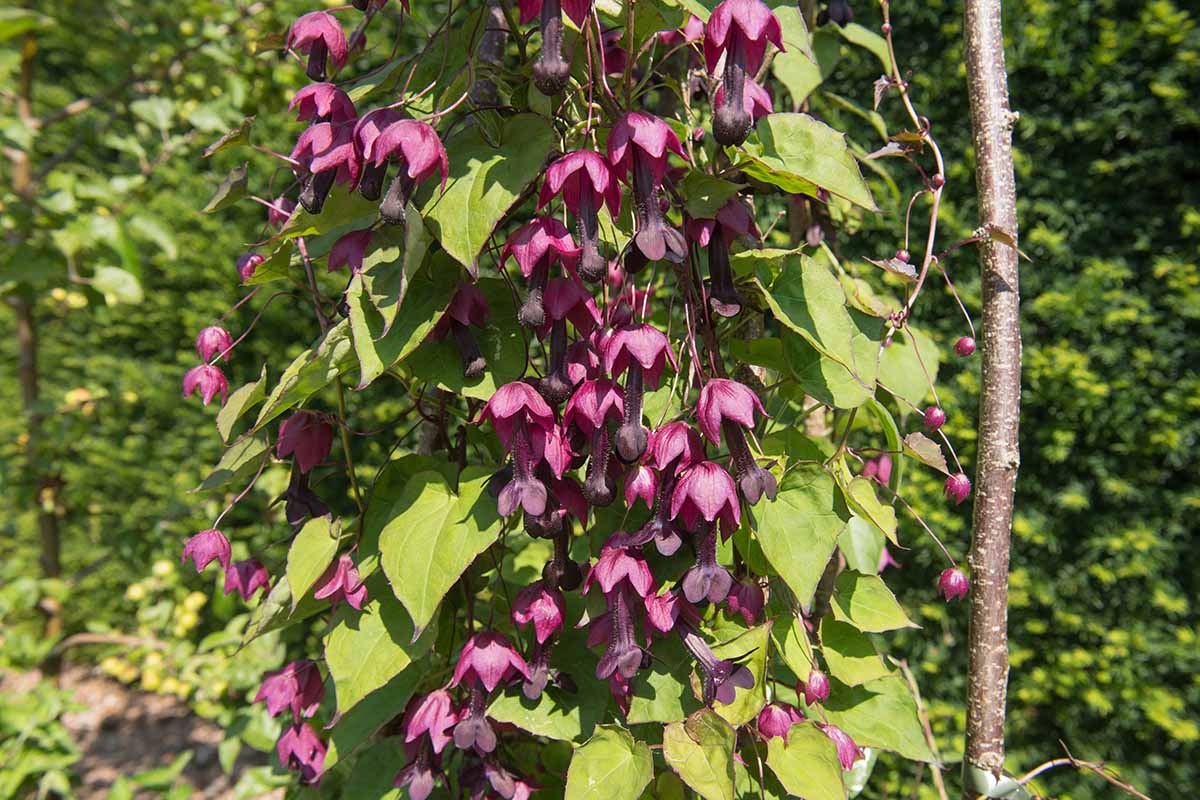
Beloved by bees and hummingbirds, the flowers have a tubular corolla of darkish eggplant purple that hangs like a clapper and is surrounded by the bell-like calyx of rosy pink sepals.
This twining Mexican native does finest in full to half solar and climbs as much as 10 ft on arbors, pergolas, and trellises. Hardy in Zones 8 to 10.
15. Silver Fleeceflower
A vigorous scrambler, silver fleeceflower (Fallopia aubertii, syn. Polygonum aubertii) is an Asian native and options aromatic clouds of sentimental, lacy flowers in drooping panicles from July to September.
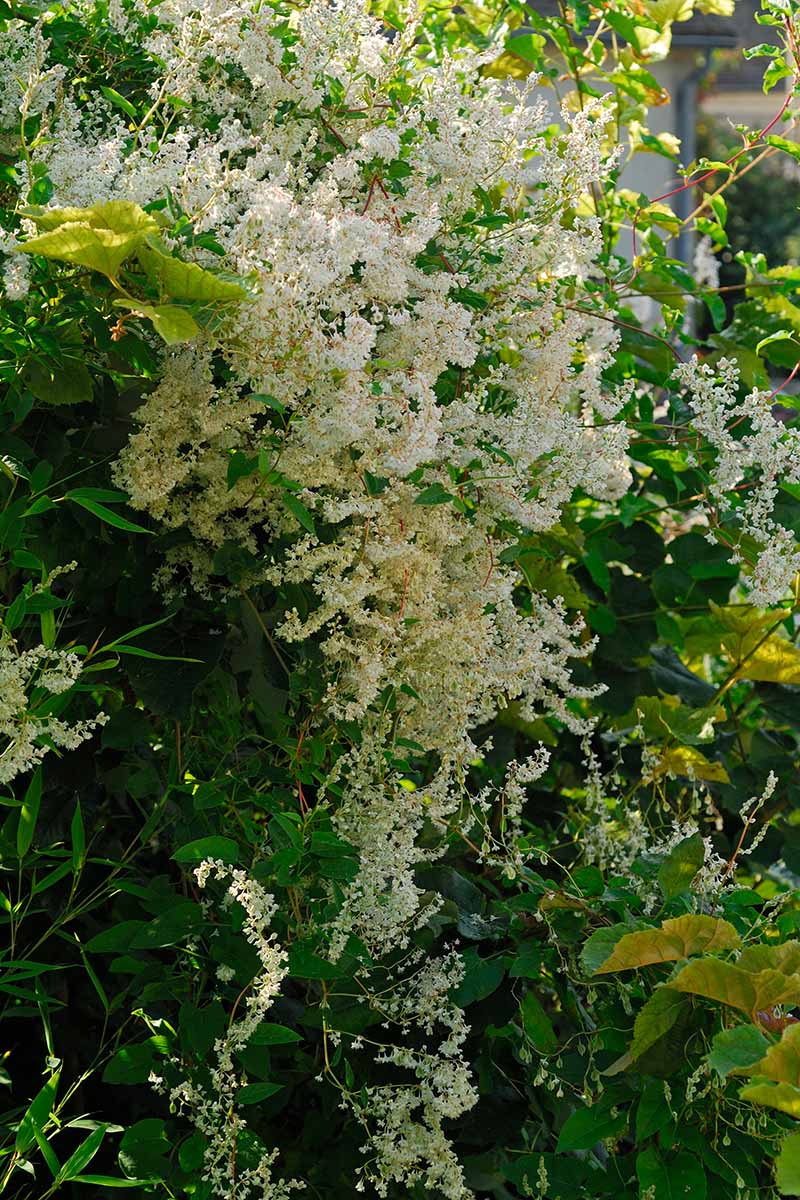
A deciduous to semi-evergreen plant with exceptionally quick progress – as much as 12 ft in a single 12 months – it makes a stunning display.
And the twisting stems are improbable for clambering up and thru arbors, chain-link fences, pergolas, porches, and trellises.
The small, downy flowers entice bees and butterflies, and vegetation develop as much as 30 ft in moist soil with vivid however oblique gentle. Hardy in Zones 4 to eight.
Nonetheless, it needs to be famous this plant can shortly turn into invasive and is taken into account a weed of concern in some areas.
Hold vegetation contained to freestanding beds and reduce exhausting in spring to resize and handle progress.
16. Scarlet Runner Bean
Visually beautiful in addition to scrumptious and nutritious, scarlet runner beans (Phaseolus coccineus) are famous for his or her prolific progress – as much as 20 ft in a single season – and the brilliant, lovely scarlet flowers which are adopted by a crop of tasty beans.
A frost-tender and short-lived perennial, scarlet runner beans are native to Central America and Mexico and are most frequently grown as an annual decorative or vegetable.
With their lush foliage and fairly flowers, they make an excellent alternative for a residing display or operating up a trellis in a sunny spot with fertile soil.
Flowering begins about two months after sowing and could be extended by commonly choosing the inexperienced beans, which could be eaten contemporary or as a shelled bean.
Seeds in packets, ounces, and one-pound sizes are accessible at True Leaf Market.
Study extra about easy methods to develop pole beans in our information.
17. Star Jasmine
An attractive evergreen, star jasmine (Trachelospermum jasminoides) produces lots of aromatic flowers in late spring to early summer season, attracting bees, butterflies, and hummingbirds.
The small star-shaped flowers of white or pink cowl twining stems that develop as much as 20 ft in full solar to partial shade.
They make a wonderful climber on arbors, fences, privateness screens, trellises, and partitions, and a fantastic floor cowl as properly.
Hardy in Zones 8 to 10, star jasmine could be grown in a container and overwintered indoors in cooler climates.
Container vegetation are accessible at Planting Tree.
18. Trumpet Vine
A vigorous grower, trumpet vine (Campsis spp.) produces a gradual parade of gorgeous and long-lasting, trumpet-shaped flowers in orange, purple, or yellow that hummingbirds flock to in droves.
This native of the jap US blooms from summer season into fall in a full solar to partial shade location and may develop as a lot as 40 ft with a sturdy assist.
C. grandiflora is rather less aggressive in its unfold than C. radicans, and all species could be saved in examine with a tough pruning in spring to handle measurement and unfold. Hardy in Zones 4 to 9.
Container vegetation of ‘Atomic Purple’ could be discovered at Nature Hills Nursery.
19. Yellow Butterfly Vine
Flowering from late spring to midsummer, the yellow butterfly vine (Mascagnia macroptera) is a fast-growing, evergreen perennial native to Central and South America.
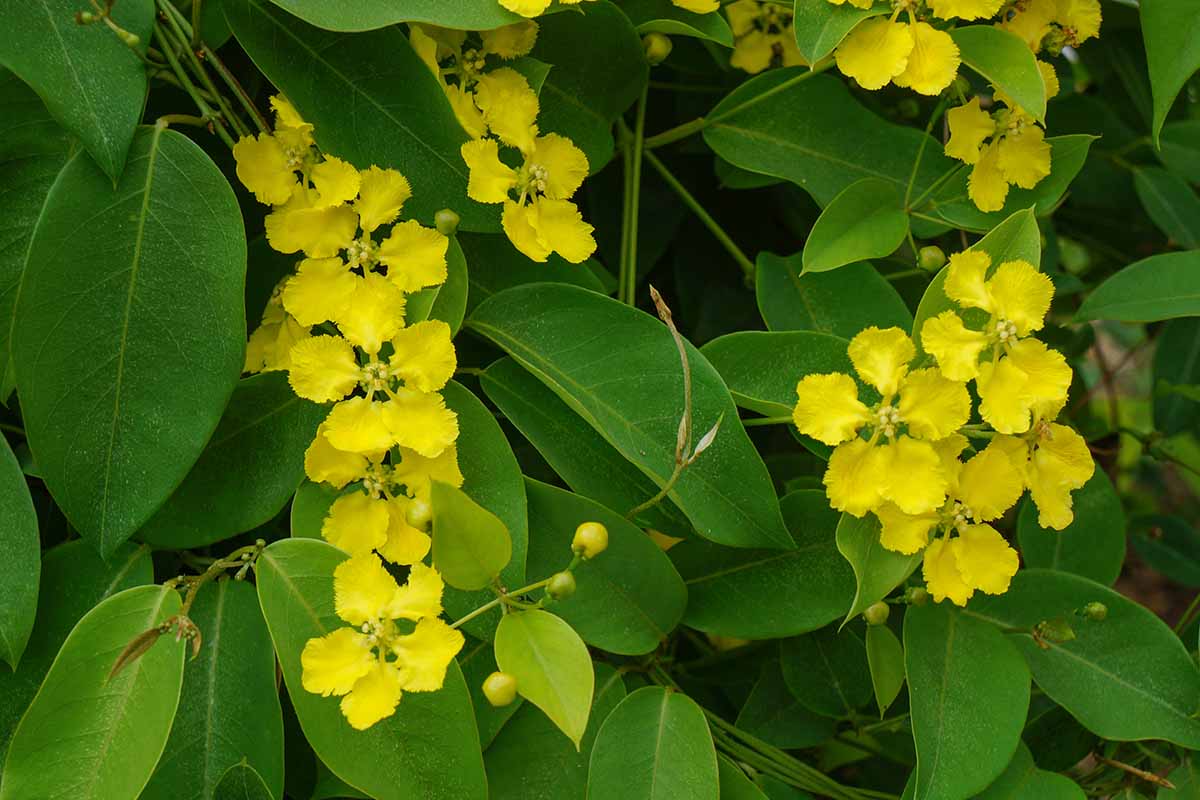
Engaging to bees and butterflies, clusters of lemon yellow flowers pop towards the darkish inexperienced foliage. These are adopted by winged, chartreuse seed pods that resemble small butterflies.
Rising as much as 12 ft with a twisting and twining behavior, yellow butterfly vine is impervious to warmth and makes a wonderful possibility for full solar places like west-facing fences, porches, or partitions, but in addition grows in partial shade. Hardy in Zones 8 to 11.
Vibrant Summer season Colour
Quick-growing and simply cultivated, climbing vines are good for including lush foliage and colourful flowers to upright buildings or to create a residing privateness display.
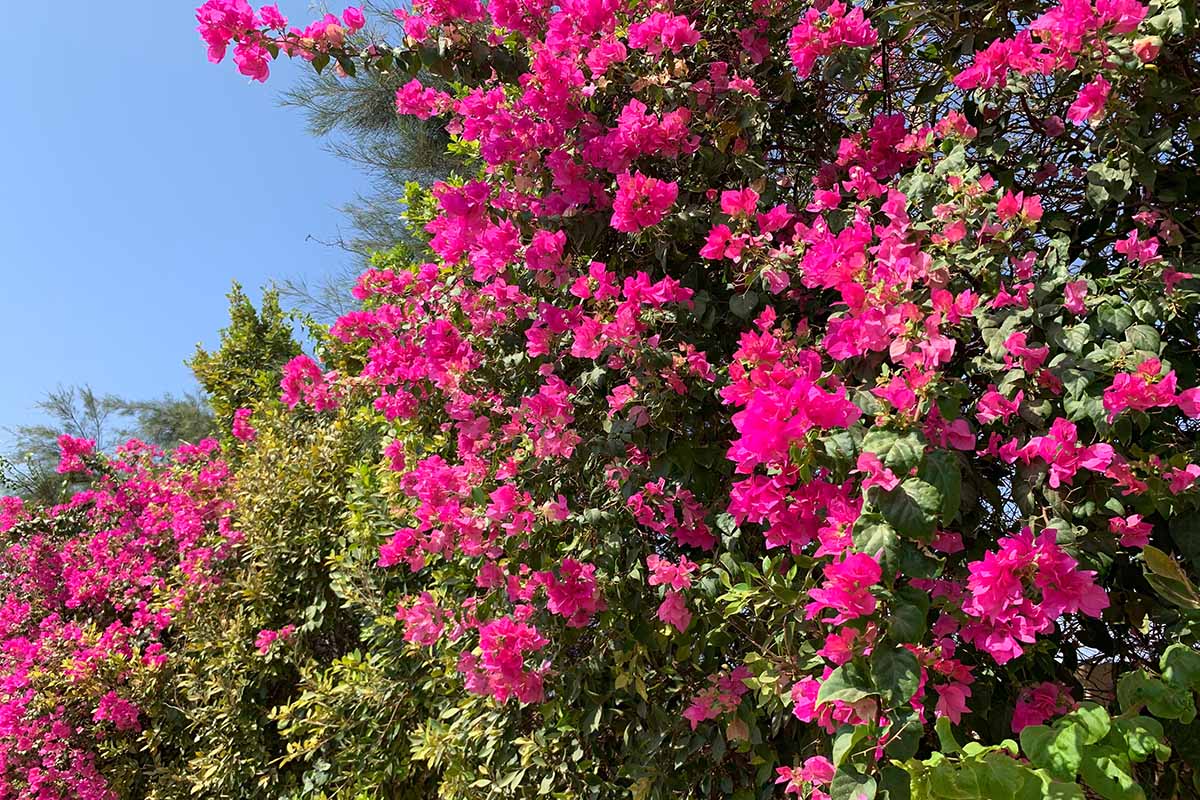
Chilly-hardy varieties appropriate to your area could be planted within the floor. And check out frost-tender ones in containers – then prune them again and transfer pots indoors for winter safety.
Nonetheless you develop them, you’re certain to be impressed with their improbable unfold and vibrant summer season colours!
And for those who’re pondering of including any vines to the backyard for good fall colours, make sure you learn these guides subsequent:

